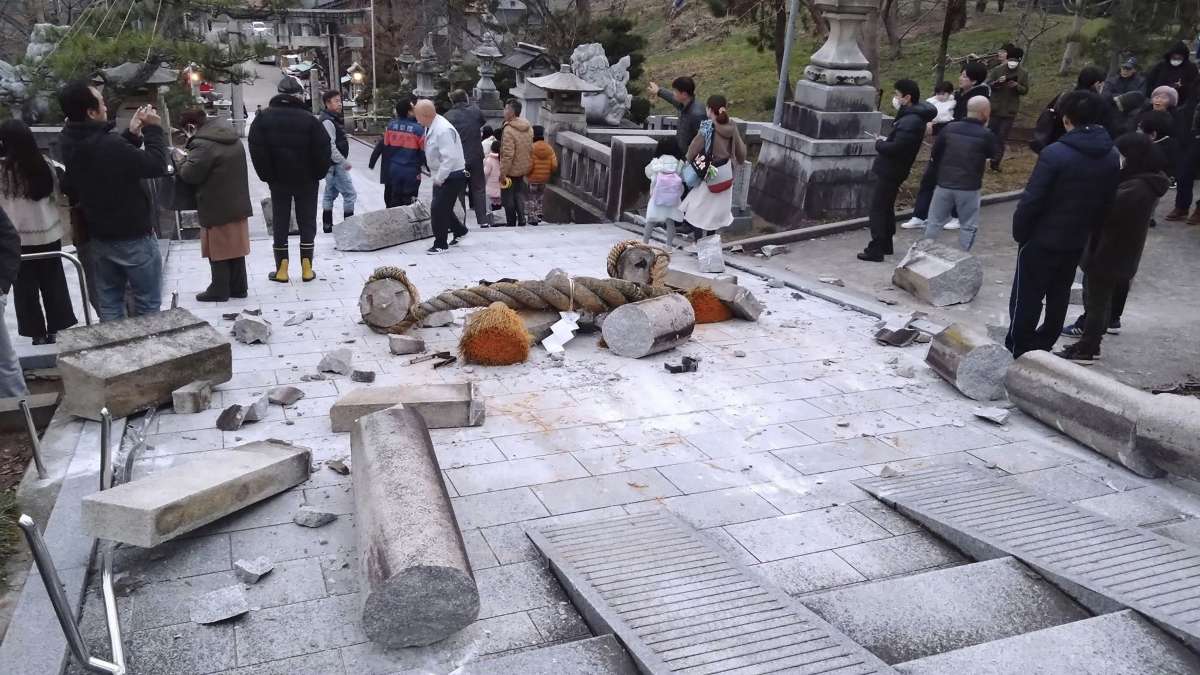

Tokyo: On the first day of 2024, Japan is rocked by a powerful earthquake, causing tremors to be felt along the northwest coast and warnings of a major tsunami. According to the Japan Meteorological Agency (JMA), the quake’s epicenter was northwest of the country’s main island, affecting Ishikawa and neighboring prefectures, with a preliminary magnitude of 7.4, while the U.S. Geological Survey recorded a preliminary magnitude of 7.5.
The earthquake tremors were felt in Tokyo and the Kanto region. According to media reports, Japanese officials have asked people to go to higher places. Meanwhile, the Japanese government has said that no abnormalities have been detected in the nuclear plants after the earthquake.
a 7.6 is absolutely no joke — it's just about as strong as the 1906 sf earthquake, which was the deadliest earthquake in the entire us history. hoping for the absolute best for everyone in japan https://t.co/C0iQqsy4uV
— wells santo (y'all islamophobic af) (@WellsLucasSanto) January 1, 2024
A low-level tsunami advisory as well as a significant tsunami warning were urgently issued for the west coast of Honshu. Based on JMA projections, water surges up to 5 meters high were expected. As a result, the government led by Prime Minister Fumio Kishida urged immediate evacuation of affected areas and advised preparations for possible additional earthquakes. Tsunami waves were predicted within 300 kilometres of the epicentre in Noto in Ishigawa after the earthquake.
Tsunami alerts for North Korea and Russia’s far eastern cities of Vladivostok and Nakhodka have been issued by the governments of both countries.
The earthquake began with a 5.7 magnitude earthquake at 4:06 pm (local time). This was followed by a 7.6-magnitude quake at 4:10 pm (local time), a 6.1 magnitude quake at 4:18 pm (local time), a 4.5 magnitude one at 4:23 pm (local time), a 4.6 magnitude quake at 4:29 pm (local time), 4.8 magnitude quake at 4:32 pm (local time). The US Geological Survey said another quake with a magnitude of 6.2 hit soon after.
The Embassy’s provision of emergency connectivity is a part of a larger initiative to ensure the safety and well-being of Indian nationals abroad, especially during unexpected natural disasters. This step underlines the Government of India’s unwavering commitment to the safety of its citizens, reflecting the proactive measures taken in times of crisis.
The Embassy has disseminated these contact details widely through various communication channels to reach as many people as possible, emphasizing the urgency and importance of being informed and prepared.
People were requested to rapidly leave coastal areas and move to the top of buildings or higher land as waves up to 5 metres hit the coast of Noto in Ishikawa following the tsunami warning, according to Japanese public broadcaster NHK. Local Met office said as many as 21 earthquakes with magnitude 4.0 were recorded, sources reported.
As residents grappled with the aftershocks, damage to infrastructure became apparent. Buildings collapsed, fires broke out and power went out, plunging thousands of homes into darkness. Major highways were closed near the epicenter, and bullet train services between Tokyo and Ishikawa were suspended. Despite immediate damage, the fire department reported no significant damage to critical facilities.
These alerts are part of a comprehensive response to a seismic event, aimed at reducing the potential impact on communities and ensuring the safety of residents around the earthquake and subsequent tsunami. The Japan Meteorological Agency expects aftershocks and a tsunami up to a week after the initial earthquake. Specific warnings have been issued for the coastal prefectures of Ishikawa, Niigata and Toyama, where waves up to five meters high could potentially hit.
In response, telecommunications operators reported disruptions in phone and Internet service in Ishikawa and Niigata, and Japanese airlines canceled flights to the affected areas. The Nuclear Regulation Authority confirmed there were no irregularities at nuclear power plants along the Sea of Japan, bringing some relief amid the chaos.